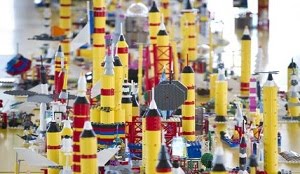CAPE CANAVERAL, Fla. -- Space shuttle Discovery and its seven-member crew lifted off from NASA's Kennedy Space Center at 7:43 p.m. EDT Sunday to deliver the final set of power-generating solar array wings and a new crew member to the International Space Station.
Discovery's STS-119 flight is carrying the space station's fourth and final set of solar array wings, completing the station's truss, or backbone. The arrays will provide the electricity to fully power science experiments and support the station's expanded crew of six in May. The 13-day mission will feature three spacewalks to help install the S6 truss segment to the starboard, or right, side of the station and deploy its solar arrays. The flight also will replace a failed unit for a system that converts urine to potable water.
Shortly before launch, Commander Lee Archambault thanked the teams that helped make the launch possible.
"It's truly an honor to be part of this team representing NASA, the nation and the international partners," Archambault said. "See you in a couple of weeks."
Archambault is joined on STS-119 by Pilot Tony Antonelli and Mission Specialists Joseph Acaba, Steve Swanson, Richard Arnold, John Phillips and Japan Aerospace Exploration Agency astronaut Koichi Wakata. Wakata will replace space station crew member Sandra Magnus, who has been aboard the station for more than four months. He will return to Earth during the next station shuttle mission, STS-127, targeted to launch in June 2009.
Former science teachers Acaba and Arnold are now fully-trained NASA astronauts. They are making their first journey to orbit on the mission and will to step outside the station to conduct critical spacewalking tasks.
Discovery's launch was postponed Wednesday, March 11, after a leak associated with the gaseous hydrogen venting system was detected during fueling. Technicians rebuilt and replaced seals and other components associated with the system. No leaks were detected during the Sunday's fueling.
NASA is providing continuous television and Internet coverage of Discovery's mission, which is the 125th shuttle flight, the 36th for Discovery and the 28th shuttle mission to the station. NASA Television features live mission events, daily mission status news conferences and 24-hour commentary. NASA TV is webcast at:
http://www.nasa.gov/ntv
NASA's Web coverage of STS-119 includes current mission information, interactive features, news conference images, graphics and videos. Mission coverage, including the latest NASA TV schedule, also is available on the main space shuttle Web site at:
http://www.nasa.gov/shuttle
Live updates to the NASA News Twitter feed will be added throughout the shuttle mission and landing. To access the NASA News Twitter feed and other agency Twitter feeds, visit:
http://www.nasa.gov/collaborate
Daily news conferences with STS-119 mission managers will take place at NASA's Johnson Space Center, Houston. During normal business hours of 8 a.m. to 5 p.m. EDT Monday through Friday, reporters may ask questions from participating NASA locations. Please contact your preferred NASA facility by its daily close of business to confirm its availability before each event.
For NASA TV streaming video, downlink and schedule information, visit:
http://www.nasa.gov/ntv
Johnson will operate a telephone bridge for media briefings that occur outside of normal business hours. To be eligible to use this service, reporters must possess a valid media credential issued by a NASA center or for the STS-119 mission. Media planning to use the service must contact the Johnson newsroom at 281-483-5111 no later than 15 minutes prior to the start of a briefing in which they wish to participate. Newsroom personnel will verify their credentials and transfer them to the phone bridge. The capacity of the phone bridge is limited and will be available on a first-come, first-serve basis.
For information about the International Space Station, visit:
http://www.nasa.gov/station





